2017年海南桥牌节公报第6期
海南省文化广电出版体育厅关于印发《海南省扑克运动管理办法(试行)》的通知-琼文体[2013]15号
![海南省文化广电出版体育厅关于印发《海南省扑克运动管理办法(试行)》的通知-琼文体[2013]15号](https://img.taocdn.com/s3/m/5150cd02fe00bed5b9f3f90f76c66137ee064ff2.png)
海南省文化广电出版体育厅关于印发《海南省扑克运动管理办法(试行)》的通知正文:---------------------------------------------------------------------------------------------------------------------------------------------------- 海南省文化广电出版体育厅关于印发《海南省扑克运动管理办法(试行)》的通知(琼文体〔2013〕15号)省扑克运动管理中心:为落实国家体育总局棋牌运动管理中心关于支持我省试行开展复式(德州)扑克项目的批复精神,规范、发展全省扑克运动,促进扑克运动健康、有序发展,根据国家相关体育法规规章,结合本省实际,研究制定了《海南省扑克运动管理办法(暂行)》。
现印发你们,请遵照执行。
特此通知。
海南省文化广电出版体育厅2013年2月20日海南省扑克运动管理办法(试行)第一章总则第一条为加强对全省扑克运动的管理,规范、净化扑克运动的发展环境,促进扑克运动健康、有序发展,根据国家体育管理法规规章和体育总局棋牌运动管理中心关于支持我省开展扑克项目的政策,结合本省实际,制定本办法。
第二条本办法所指扑克运动是指除桥牌以外的各类扑克运动。
第三条海南省扑克运动管理中心(以下简称“省扑克管理中心”)是全省扑克运动的业务主管单位。
扑克运动的管理,应遵循“服务、引导、规范”的管理宗旨,科学合理、积极稳妥推进扑克运动项目的活动组织、普及推广等,使扑克运动更好地起到丰富群众文化生活,活跃旅游经济环境,营造和谐社会氛围的作用。
第二章组织管理第四条扑克运动组织是指各级扑克运动协会以及以开展扑克活动为主要内容的组织。
第五条省扑克管理中心负责海南省扑克运动协会的组织建设和管理工作。
各类扑克运动协会和相关组织均可申请成为海南省扑克协会会员。
省扑克管理中心与所属各扑克运动协会之间是业务指导关系。
第届全国智力运动会海南省桥牌选拔赛竞赛规程-V1
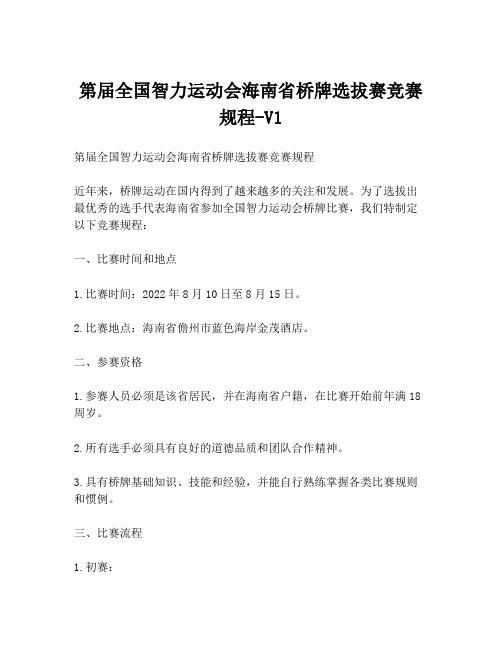
第届全国智力运动会海南省桥牌选拔赛竞赛规程-V1第届全国智力运动会海南省桥牌选拔赛竞赛规程近年来,桥牌运动在国内得到了越来越多的关注和发展。
为了选拔出最优秀的选手代表海南省参加全国智力运动会桥牌比赛,我们特制定以下竞赛规程:一、比赛时间和地点1.比赛时间:2022年8月10日至8月15日。
2.比赛地点:海南省儋州市蓝色海岸金茂酒店。
二、参赛资格1.参赛人员必须是该省居民,并在海南省户籍,在比赛开始前年满18周岁。
2.所有选手必须具有良好的道德品质和团队合作精神。
3.具有桥牌基础知识、技能和经验,并能自行熟练掌握各类比赛规则和惯例。
三、比赛流程1.初赛:初赛将分两轮进行,每轮比赛共进行24个牌手四局过程,总共进行8轮比赛。
比赛采用瑞士制,积分最高的16名选手晋级决赛。
2.决赛:决赛采用双人对抗,共进行16个牌手晋级比赛。
决赛将进行6局比赛,比赛结束后,总积分最高的选手将代表海南省参加全国智力运动会桥牌比赛。
四、比赛规则1.所有比赛采用国际桥牌联盟的比赛规则和惯例。
2.比赛分为分组和对抗两个阶段。
3.比赛时间限制,每小局不超过15分钟,比赛进行期间所有选手必须保持安静。
4.所有选择均在比赛前公平抽签决定,在比赛中不得变更。
五、裁判及判罚1.比赛期间,裁判可以在必要时对选手进行惩罚。
2.比赛规则之外的事宜由比赛组委会决定。
六、奖项设置1.单人比赛:第一名奖金人民币5万元,第二名奖金人民币3万元,第三名奖金人民币2万元。
余下的选手将获得纪念奖。
2.团体比赛:第一名奖金人民币10万元,第二名奖金人民币6万元,第三名奖金人民币4万元。
余下的选手将获得纪念奖。
总之,海南省桥牌选拔赛将为全国智力运动会桥牌比赛选手的选拔提供更充分的技能和经验积累,我们希望届时能有更多的优秀选手参与比赛,向全国展现海南省桥牌运动发展的成果和实力。
桥牌标准精确 开叫与应叫表
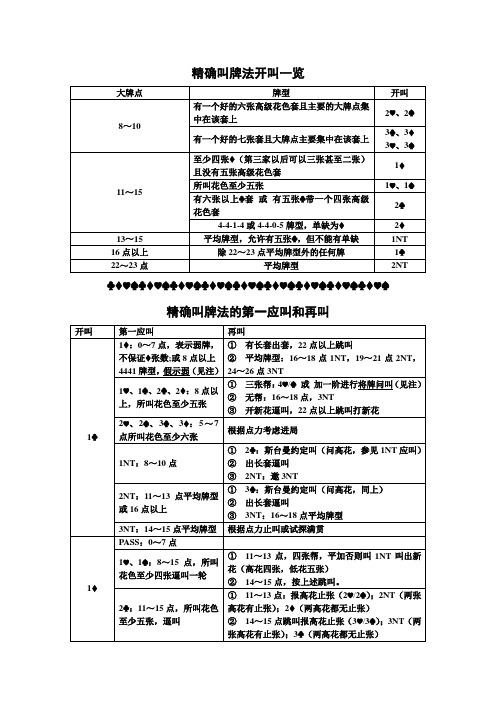
精确叫牌法开叫一览
♣♦♥♠♣♦♥♠♣♦♥♠♣♦♥♠♣♦♥♠♣♦♥♠♣♦♥♠♣♦♥♠♣♦♥♠精确叫牌法的第一应叫和再叫
♣♦♥♠♣♦♥♠♣♦♥♠♣♦♥♠♣♦♥♠♣♦♥♠♣♦♥♠♣♦♥♠♣♦♥♠
注:
1、将牌问叫:1♣开叫,示强花色应叫后,开叫人立即加一阶。
另外还有4NT的“罗马关键张问叫”:与问A不同的是,这一问叫把将牌K也算作一个A。
延伸——还可用5NT问K。
3、问叫被干扰时:Pass,相当于原一级回答;×,相当于原二级回答;
在对方叫品上加一级,相当于原三级回答;在对方叫品上加二级,相当于原四级回答……4、1♣—1♦(假示弱):己方假示弱,同伴再叫,此时己方进行跳叫(所叫花色为单缺;如果开叫方出套为己方单缺花色,则跳叫无将);但如果同伴叫2NT或3NT,切不可跳叫,可用3♣或4♣进行斯台曼问叫。
1♦假示弱的牌并不常见,初学也不太好掌握,当执有8点以上4441牌型的牌时,可以用1NT代替1♦进行应叫,之后双方正常进行。
5、高限与低限:自己叫品点力范围内最大的两个点力为高限,其余为低限。
套:指一门花色,有N张就叫做N张套。
高花套:♥或♠套;低花套:♣或♦套。
逼叫:即逼同伴应叫,被逼叫方没有停叫的权利;邀叫:邀请同伴高限进局。
跳叫:不连续叫牌,如有人叫2C,我不叫2S而叫3S即跳叫;双跳叫:跳叫两阶。
第四届全国智力运动会桥牌比赛男子团体.pdf
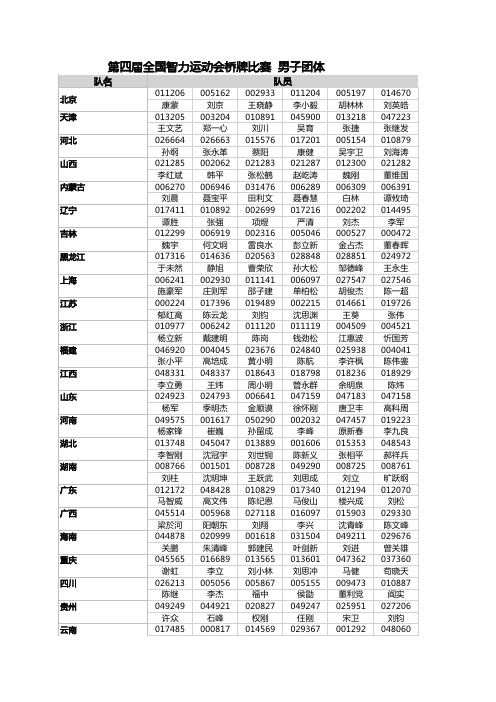
杜健 004503 应国明 050667 薛苏闽 002932 王为民 010984 曹雪良 024603 徐冰石 046919
赵宇 005055
石淼 010319 姜新华 005103 马春秋 026492
张磊 020667
姚志
于丹 039910
郁红高 陈云龙
刘钧
沈思渊
010977 006242 011120 011119
杨立新 戴建明
陈岗
钱劲松
046920 张小平
004045 高培成
023676 黄小明
024840 陈航
048331 048337 018643 018798
李立勇
王炜
周小明 管永群
024923 024793 006641 047159
李戎 045909 王亚魁 009636 马永宁 000507 邬雪男 048499 李海峰 030430 蔡中至 048423
张昭 056040 麦国辉 013250
陈军 046931 李春山 046263 陈学斌 026310 侯国峻 019498 李建伟 001565 刘士敏 01946 刘运青 018710 罗小丹 031990 杨文君 010920
刘姝 006934 于丁一 025915 黄晓雅 010914 王文霏 021803
王南 010913
章瑜 049513 林爱梅 018708
余波 022002 徐爱美 013795
陈军 048795
陈琦 011408 伍少红 019798 柴俊阳 049292
北京 天津 河北 山西 内蒙古 辽宁 吉林 黑龙江 上海 江苏 浙江 福建 江西 山东 河南 湖北 湖南 广东 广西 海南 重庆 四川 贵州 云南
最新桥牌世界标准2017版 BRIDGE WORLD STANDARD 2017
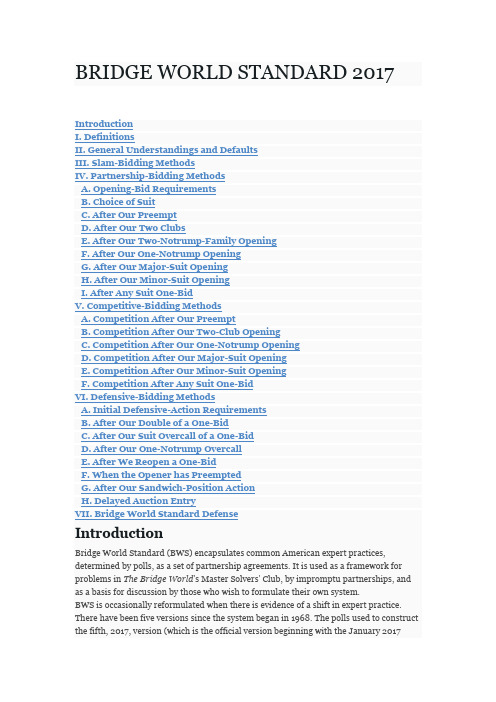
BRIDGE WORLD STANDARD 2017Master Solvers' Club problems) appear in Bridge World issues for the months of March, April, May and June 2016 and at I. DefinitionsA distribution shown with hyphens refers to any pattern including those suit lengths (for example, 5-4-3-1 means any hand with one five-card suit, one four-card suit, one tripleton and one singleton). A distribution shown with equal signs refers to specific suit lengths (for example, 5=4=3=1 means a hand with five spades, four hearts, three diamonds and one club). Balanced means 4-3-3-3, 4-4-3-2 or 5-3-3-2.A competitive action is one taken over an opponent's bid, double or redouble. A competitive action taken in direct position immediately follows an opponent's action; one taken in reopening position follows an opponent's action and two passes.Points refer to 4-3-2-1 high-card points (HCP).Adjectives for double:takeout: Announces a hand-type that suggests reaching a contract in other than the current strain.cooperative-takeout: Suggests that partner take out with normal distribution for the earlier auction, pass only with strong defensive orientation.cooperative-penalty: Suggests that partner pass with normal distribution for the earlier auction, take out only with strong offensive orientation.penalty: Suggests that partner pass.II. General Understandings and DefaultsArtificial bid doubled: After an opponent's double of an artificial bid, a simple return to an agreed or indicated suit is the weakest action.Bypass rule: If a player bypasses a natural notrump bid to make a nonforcing bid, then later bids notrump uninvited over an opposing bid, that notrump bid is unusual (showing additional distribution, not offering to play in notrump).Conversions: When either a double or a notrump bid, when followed by a conversion, would show length in the same two suits: starting with a double suggests more in high cards, starting with a notrump bid suggests more in shape.Doubles subject to no explicit agreement:(a) when a pass would be forcing, a double discourages further offensive bidding;(b) when a pass would be nonforcing, a double is penalty if the doubler is limited, cooperative-takeout if the doubler is unlimited.Five notrump: If an undiscussed but clearly forcing noncompetitive five-notrump bid might logically be interpreted as more than one of these alternatives, the priority order of interpretation is: (1) choice of slam, (2) Grand-Slam Force, (3) control-showing. Forcing vs. nonforcing: When a call could logically be interpreted as either forcing or nonforcing, and there is no explicit agreement: In a competitive situation, treat as nonforcing; in a noncompetitive situation, treat as forcing or nonforcing by which seems more sensible to the observer. Specific cases:(a) Vulnerability exerts influence solely in that some situations are forcing only when our side is vulnerable against not. Those situations include at least when the opponents bid ator above game and our side has shown strength or itself bid game nonpreemptively (but there is no explicit agreement about other cases).(b) If we have been forced to game but have not bid game, competitive situations thereafter above the game level are forcing.(c) If we have bid game nonpreemptively, the default applies.(d) If we have invited game and the invitation has not been declined, competitive situations thereafter are forcing only as high as where the force would have expired noncompetitively.(e) A two-notrump opening does not create a force if the opponents bid.(f) If a two-club opening is overcalled, responder's pass is forcing at every level.(g) No force is created after: (1) our penalty double or penalty pass of a takeout double when the partnership is not otherwise committed to further bidding; (2) an opponent raises over our takeout double, simple overcall, or jump-overcall of a preemptive opening;(3) an opponent's preemptive bid over our one-over-one response; (4) astrength-showing redouble by an already-limited hand.(h) A strength-showing redouble by an unlimited hand creates a force to at least a level dictated by the logic of the auction. Special case: A new-suit bid by opener after responder's redouble of a suit one-bid is nonforcing.Form of scoring: BWS makes no adjustments in its agreements to match changes in the form of scoring (as in matchpoints vs. imps).Four notrump:(a) If an undiscussed but clearly forcing noncompetitive four-notrump bid might logically be interpreted as more than one of these alternatives, the priority order of interpretation is: (1) ace- or key-card-asking, (2) general slam encouragement, (3) control-showing; (b) If an undiscussed competitive four-notrump bid that might logically be interpreted as more than one among these alternatives, the priority order is (1) takeout, (2)key-card-asking, (3) ace-asking.Interpretation priorities: When a call is subject to different possible interpretations and there is no explicit system agreement, it should be considered as follows:(a) natural rather than artificial;(b) if a double, the most sensible interpretation to the observer;(c) lead-directing or not by which seems more sensible to the observer;(d) if a redouble, business or escape by which seems more sensible to the observer;(e) if a pass over an opponent's redouble, penalty or escape by which seems more sensible to the observer.Jumps:(a) the default interpretation of an otherwise-undefined bid one level above astrength-showing force (e.g., one club - one diamond - one heart - three spades) is a splinter;(b) the default interpretation of a bid one level above a splinter (e.g., one spade - five diamonds) is Exclusion Key-Card Blackwood. Exceptions include: A triple jump-response of four of a major is natural (preemptive in nature).Lead-directing doubles:(a) a double of a suitless auction to three notrump or four notrump requests the lead ofleader's shorter major;(b) no special lead is suggested by a double: (1) of a suitless auction to six notrump or seven notrump; (2) when some combination of dummy's suit, leader's suit, and doubler's suit is available; (3) when there are expected and unexpected leads; or (4) after the opponents' previously uncontested Stayman auction;(c) a double for an unusual lead against a suit contract cancels any earlier lead-directional messages.Opposing doubles: When a forcing bid is doubled and there is no contrary explicit system agreement or logic from the auction, a pass is forcing and a redouble is to play (suggests a contract).Passed-hand situations: When it is logically possible and there is no explicit understanding to the contrary, an action taken by a passed hand has the same general meaning as the corresponding action taken by an unpassed hand, subject to whatever constraints are imposed by the failure to open the bidding.Passes over redoubles: A pass over a redouble is:(a) for penalty when a preemptive opening is doubled in either position, a suit one-bid is doubled in reopening position, or a bid at the two-level or higher is doubled after the opponents have bid three or more times;(b) for takeout when a suit one-bid is doubled in direct position or a new-suit response is doubled;(c) subject to no special agreement when a raise of a one-bid is doubled, or aone-notrump response is doubled, or a one-level bid after the opponents have bid three or more times is doubled.Redoubles: A redouble is natural (to play) except the following, which are for takeout: any redouble in passout seat when at least two other strains are possible; opener's redouble of the direct double of a suit one-bid passed for penalty; advancer's redouble of either the penalty double of a simple overcall of a one-bid or the double of a two-notrump overcall of a weak two-bid.Splinters vs. Fragments: When two bids are to be used systemically to show distribution, and either each will show shortness in the suit bid ("splinter") or each will show shortness in the suit left unbid ("fragment"), the splinter interpretation applies in all cases.Suit jumps: If an undiscussed competitive suit jump might logically be interpreted in more than one way, it is natural.Two notrump: Competitive two-notrump bids that might be used artificially to help distinguish actions designed to contest the auction from those of a constructive nature are natural.III. Slam-Bidding MethodsAce- and Key-Card-Asking:(a) When a four-notrump bid is Key-Card Blackwood (KCB), the replies are: five clubs = 0 or 3 key cards; five diamonds = 1 or 4; five hearts (spades) = 2 without (with) the trump queen.(b) When a four-notrump bid is Six-Key-Card Blackwood (6KCB), the replies are similar with "trump queen" replaced by "key queen."(c) When a four-notrump bid is Blackwood but is neither KCB nor 6KCB, or when a bid other than four notrump or four clubs asks for aces, the replies are 0|3-1|4 [one step = 0 or 3 aces; two steps = 1 or 4; three steps = 2].(d) When Gerber (four clubs asking for aces) is used, the replies are in steps: one step = 0 aces, two steps = 1 ace, and so forth.Agreed Suit and Number of Keys:When four notrump is a key-card ask, it is 6KCB when and only when two suits have been supported. In KCB, absent an explicit agreement, the priority order for determining the agreed suit is: the only supported suit; the only shown suit; the most recently shown suit. Specific cases:(a) After a two-club opening and a later Blackwood four-notrump bid by opener when there is no explicitly agreed suit: If opener has shown length in only one suit, four notrump is KCB with that suit agreed; otherwise, it is KCB and the usual rules apply. (b) When the response to a suit one-bid is a strong jump-shift, and responder then bids four notrump, that is KCB in responder's suit.Approaches to slam decisions:First Slam-Try: When the first slam-try after suit agreement is made by a player who has shown no suit other than the agreed suit, it shows length in the bid suit (or, when applicable, where a high-card value will be especially useful).Kaplan Control Principles: When there is an agreed suit:(a) After a slam-try by one partner at or below four of the agreed suit: (1) a non-signoff bid or redouble by the other is slam-positive and indicates a specific control; (2) failure to show a control is slam-negative, but does not deny that control.(b) After a slam-try by one partner above four of the agreed suit, the other must show any biddable control below five of the agreed suit (and doing so carries no implication of overall extra values).Last Train: Any time there is only one call that indicates slam interest or further slam interest without raising the partnership's level of commitment, it is a Last-Train slam-try, unrelated to the strain named (unless followed by an uninvited further action: a voluntary continuation by the Last-Train bidder converts the Last-Train bid to a control-bid).Mild and Serious Slam-Tries: When an eight-plus-card major-suit fit has been established, neither partner has made a natural two-notrump bid, and the auction is forcing to game, a nonjump bid of three notrump is a mild slam-try, and a control-bid or a long-suit indicator is a strong slam-try.Open suit: When one partner has requested that the other (replier) bid slam with at least second-round control of a particular suit (the open suit) regardless of the rest of the holding, this scheme is used for replier's actions: with no control in the open suit, pass or return to (usually five of) the agreed suit; with second-round control, bid six of the agreed suit (or five notrump with the guarded king); with first-round control, control-bid in theopen suit (or, with, additionally, first-round or maximum-possible and anas-yet-unshown control in another suit, control-bid in that suit).Asking follow-ups:(a) A later bid in the agreed suit (or, in 6KCB, in either of the raised suits) is a signoff (but Teller, with the higher number of key cards for an ambiguous initial reply, may bid on).(b) After a 0|3 or 1|4 reply to KCB, the cheapest forcing bid by the Blackwood bidder other than a specific-king-ask is a trump-queen-ask, and the negative reply is a return to the agreed suit. After a 0|3 or 1|4 reply to 6KCB, the cheapest bid by the Blackwood bidder below five of a raised suit is a queen-ask relating to both raised suits, with replies in steps: one step, no queen; two steps, one queen; three or more steps, two queens. (c) A five-notrump bid by the Blackwood (or KCB or 6KCB) bidder confirms partnership possession of all the aces (or of all key cards and the trump queen or key queens or equivalents), invites a grand slam, and asks for specific kings outside the agreed suit (in KCB) or outside the raised suits (in 6KCB).Exclusion Blackwood: When a call is defined as Exclusion Blackwood (EB), the replies are in steps similar to Key-Card Blackwood, but the replier does not count the ace of an excluded suit. The EB interpretation applies to certain jumps that name an excluded suit, and also when a player makes a slam-try, indicates a short suit, receives no encouragement, and then bids four notrump (in which case the indicated short suit is an excluded suit).Grand-Slam Force: When a five-notrump bid is the Grand-Slam Force:(a) The scheme for determining the agreed suit is the same as it is for Key-Card Blackwood.(b) Replier bids above the agreed suit with two (or three) of the top three trump honors. With a lesser trump holding, he bids cheapest-weakest (the higher the bid, the stronger the holding).Interference:(a) When there is interference after an ace- or key-card-ask, the replies are: (1) at low enough levels, DOPI (double or redouble = 0 or 0|3, pass = 1 or 1|4, cheapest bid = 2 or 2 without the trump queen, etc.); (2) at high enough levels, DEPO (double = even, pass = odd).(b) When there is interference after a Grand-Slam Force, the replies are: (1) at low enough levels, DOPI (double or redouble substitutes for what would have been the cheapest bid, pass substitutes for what would have been the second-cheapest bid, the cheapest bid substitutes for what would have been the third-cheapest bid, etc., subject to the logic of the auction); (2) at high enough levels, DEPO (double = even, pass = odd). (c) When an artificial slam-try (such as a control-bid or a splinter) is doubled, the weakest action by the next player to speak is a return to the agreed suit (or whatever would have been the weakest action without the double).Pass and Pull: Making a forcing pass and pulling partner's double is stronger than the same action taken directly.Slow arrival: Except where there is a specific agreement to the contrary, when there is a choice between two game-forcing bids in a particular strain, BWS uses slow arrival (ajump is either stronger than a simple bid or it is a picture bid with a specific descriptive meaning).Voids: A reply to an ace- or key-card-ask above the usual range shows a void:(a) the cheapest void-showing reply shows two [or an even number of] aces or key cards, plus a void;(b) a higher action indicates one [or an odd number of] aces or key cards, plus a void, and, when possible, indicates the suit of the void.IV. Partnership-Bidding MethodsThis section describes agreements about auctions in which our side makes the first bid and the opponents do nothing but pass.A. Opening-Bid RequirementsBWS-2017 is a mostly natural system based on an artificial, strong two-club opening, weak two-bids in the other suits, strong notrump (with Stayman and transfers), andfive-card majors (with a semi-forcing one-notrump response and game-forcingtwo-over-one responses). Opening requirements are neither extremely sound nor light. The minimum requirement to open with a long minor is about half a point higher than with a long major.♠ A Q x xx ♥ A x x ♦ J x xx ♣ xis a minimum one-spade opening bid as dealer with neither side vulnerable.♠ A K Q J 10 ♥ A K Q ♦ K 10 9 x ♣ xor♠ A K Q J 10 ♥ A K Q ♦ Q 10 9 x ♣ xis a minimum two-club opening bid as dealer with neither side vulnerable.This scheme is used for opening the bidding with a balanced hand:suit, then minimum notrump: 12 to 14 HCPone notrump: 15 to 17 HCPsuit, then strong action in notrump: 18 to 19 HCPtwo notrump: 20 to weak 22 HCPtwo clubs, then minimum notrump: strong 22 to 24 HCPtwo clubs, then two hearts (Birthright) over a two-diamond response, then two notrump over a two-spade relay: 25-plus HCPIt is optional to open one notrump with any of these distributions: 5-3-3-2 with a long major, 2=4=2=5, 2=4=5=2, 6-3-2-2 with a long minor.It is acceptable to open two notrump (or two clubs, intending to rebid in notrump) with an unstopped doubleton, a five-card major, a six-card minor, or five-four distribution including a five-card minor.On the understanding that requirements within an overall style vary with form of scoring, table position and vulnerability, the BWS requirements for initial preemptive openings are not extreme in any direction.A three-notrump opening is gambling (solid seven-card minor with little side strength).An opening of four of a minor is natural.A first- or second-position weak two-bid that includes three of this list of characteristics is unacceptable: five cards in the bid suit; seven cards in the bid suit; flimsy (definition adjusted to suit the vulnerability) six cards in the bid suit; side void; side four-card or longer suit. Otherwise, opener may use judgment.B. Choice of SuitWhen opening a one-bid in a minor suit: with three-three in the minors, always bid one club; with either four-four in the minors or four diamonds, five clubs and aminimum-range hand, use judgment to decide which minor to open.With a minimum-range five-six hand, open in the higher and shorter suit only when the long suits are adjacent.On a hand calling for an opening one-bid with five-five in the black suits, opener should always bid one spade.In third or fourth position, it is acceptable to open in a strong four-card major if the auction rates to be manageable thereafter.C. After Our PreemptResponding to preemptive openings in a suit: When responder is an unpassed hand:(a1) if the opening is not in clubs and not at the four-level, a four-notrump response is an ace-ask, a four-club response is a key-card-ask;(a2) when the opening is three clubs or at the four-level, four notrump is a key-card-ask;(b) a raise of a major-suit preempt to five is a trump-ask after a four-bid, otherwise preemptive (a bar);(c) a simple new-suit response to partner's game-level preemptive opening is anasking-bid about the suit named (replies: one step, neither first- nor second-round control; two steps, second-round control; three steps, first-round control; higher, first- and second-round controls);(d) a simple below-game new-suit response is a one-round force;(e) a below-game, jump new-suit response other than four clubs is an asking-bid about the bid suit;(f) a two-notrump response to a weak two-bid invites game and suggests a fit for opener's suit.Responses to a three-notrump opening:(a) club bids are pass-or-correct;(b) four notrump is invitational;(c) four diamonds asks for side shortness (opener bids four of a major with shortness there, four notrump with no shortness, or five of a minor with shortness in the other minor;(d) any other bid is natural.Weak two-bidder's continuations: After a two-notrump response to a weak two-bid, opener's rebids are: Feature-showing with a maximum.D. After Our Two ClubsA two-diamond response to two clubs denies the values for a positive response in a hand with either a strong suit (at least six-card length or five cards headed by at least two honors) or acceptable orientation to bid notrump.A suit-bid response to two clubs from three hearts to four diamonds indicates a one-loser suit.After a two-diamond response and a natural simple new-suit rebid by opener, responder's cheapest minor-suit bid through three diamonds is a double negative (after which opener's same-suit rebid of three of a major may be passed), new-suit single jump is a splinter raise, and double raise is a picture bid (strong trumps and little else). Two clubs — two diamonds — two hearts is Birthright (responder relays with two spades, after which opener bids two notrump to show a balanced, game-going hand or anything else to show hearts and whatever shape is shown by the most-recent bid).E. After Our Two-Notrump-Family OpeningThese methods apply after a two-notrump opening bid, a two-notrump rebid by atwo-club opener following a two-diamond response, and a two-notrump rerebid by atwo-club opener in the sequence two clubs — two diamonds — two hearts (Birthright) —two spades (relay) — two notrump:(a) Texas (four-level) transfers, after which four notrump is Key-Card Blackwood and a new-suit bid is Exclusion Key-Card Blackwood;(b) Gerber;(c) three spades showing both minors;(d) Jacoby (three-level) transfers, after which a notrump bid or a new-suit bid is natural, a self-raise to the four-level is a slam-try, and a new-suit jump is an autosplinter (aone-suiter with shortness in the bid suit);(e) Stayman, with responder's three-of-a-major rebid over three diamonds Smolen. There is no agreement on the difference between showing the same major-suit shape via transfer and via Smolen.F. After Our One-Notrump OpeningResponses to a one-notrump opening:(a) Texas (four-level) transfers, after which four notrump is Key-Card Blackwood, and a new-suit bid is Exclusion Key-Card Blackwood;(b) Gerber;(c) Jacoby (two-level) transfers, after which a notrump bid or a new-suit bid is natural (Transferring to spades and then bidding hearts shows at least five-five. Transferring to hearts and then bidding two spades shows at least four spades, at least five hearts, and at least game-invitational strength; this is the only way to invite game with four spades and five hearts. Over two spades, opener with a minimum bids three of a major or two notrump, any of which responder may pass; with a maximum, opener bids something else, which is a game-force.); a self-raise to the three-level is invitational; a self-raise to the four-level is a slam-try; and a new-suit jump is an autosplinter (a one-suiter with shortness in the bid suit);(d) Stayman (possibly a weak hand; opener bids hearts with both majors), followed by responder's bid of: (i) two hearts is weak (scrambling for a two-level contract with length in both majors); (ii) two spades is invitational; (iii) three of a major is invitational if a direct raise, or Smolen (forcing; ostensibly four of the bid major and five of the other) if over two diamonds, or a slam-try in opener's shown major with an unspecified splinter if in the unbid major (then, the cheapest bid by opener is a relay and responder shows the short suit in steps: lowest-|middle-|highest-ranking possible short suit; if a step bid would be inappropriately nonforcing, the next available bid substitutes for it); (iv) four clubs is a key-card-ask if opener showed a major, otherwise shows four=six in the majors; (v) four diamonds is a slam-try in opener's major with no short suit, otherwise showssix=four in the majors;(e) modified four-suit transfers with two spades = either a range inquiry (opener bids two notrump with a minimum) or clubs (simple new-suit rebid by responder shows shortness), two notrump = diamonds (simple new-suit rebid by responder shows shortness), three clubs = both minors weak (nonforcing), three of another suit = both minors strong (three diamonds = no major-suit shortness; three of a major = at most one card in the suit bid).G. After Our Major-Suit Opening(See also section I., below)Responder is unpassed except where otherwise stated.Responses:(a) a one-notrump response is semiforcing (limited to at most game-invitational strength; opener may pass with 5-3-3-2 or 4=5=2=2 and a hand deemed no stronger than 12high-card points);(b) a two-over-one response is forcing to game;(c) a single raise is moderately constructive (when responding with a weaker fitting hand, bid one notrump planning to rebid two of the major, a sequence that could also show 6-9 HCP and a doubleton fit);(d) a double raise is invitational with four or more trumps (with equivalent values and only three trumps, respond one notrump planning to rebid three of the major after a minimum new-suit rebid);(e) two notrump (no side shortness) or a new-suit double jump (splinter) showsgame-forcing strength with at least a four-card fit;(f) a jump-shift to three of an underranking suit is invitational; a two-spade response to one heart is strong and indicates a hand stronger than ordinary game-going values [a strong jump-shift shows more than ordinary game-going strength (the equivalent of16-plus HCP), a substantial suit (at least five-card length with at least two of the top three honors), and one of three hand-types: balanced, one-suited, support];(g) three notrump or a triple raise is a weak preemptive raise, the former showing some defensive strength;(h) a double jump-shift is a splinter;(i) except for one heart - four spades (which is natural), a triple jump-shift is Exclusion Key-Card Blackwood.Opener's rebids:After a one-spade response to one heart:(a) a one-notrump or two-notrump rebid may include a singleton spade;(b) a three-notrump rebid shows long, strong hearts;(c) a four-heart rebid is unrestricted as to spade length;(d) a four-of-a-minor rebid is a splinter raise.One heart — one notrump — two spades is forcing.One of a major — one notrump — two notrump is invitational; responder's continuation of three of a suit other than opener's is a transfer.One of a major — one notrump — rebid one level above a forcing reverse or jump-shift is an autosplinter (big one-suiter; shortness bid).After a two-over-one response, a two-level reverse or a non-jump three-level new-suit bid shows extra strength, but two notrump or a single raise may be based on a minimum hand.After a single raise:(a) a reraise to three is preemptive;(b) two notrump is forcing with at least game-invitational strength;(c) a simple new-suit bid is a game-try showing length (or a suit where honor strength would be helpful).After a two-notrump forcing raise: a simple new-suit bid shows shortness, a new-suit jump shows a two-suiter, and the three other game-and-below bids (simple same-suit rebid, three notrump, jump same-suit rebid), herein called TOBs, deny the requirements for any new-suit bid. The TOBs are graded from strongest to weakest (cheapest bid is strongest).After a direct game-invitational raise to three of opener's major: the cheapest bid asks for shortness. One heart — three hearts — three notrump is a control-bid in spades. Later actions:(a) After one heart — one notrump — two of a minor — ?, two spades is a strong raise of opener's minor and is forcing to three of opener's minor;(b) After one spade — one notrump — two diamonds — ?, three hearts is a strong raise of diamonds that bears no direct relationship to hearts;(c) After one heart — one notrump — two clubs — ?, three diamonds shows long diamonds in a hand improved by the two-club bid;(d) After one of a major — one notrump — two of a lower-ranking suit — ? or aone-notrump response and a jump-shift, four of a suit ranking below opener's second suit is a control-bid supporting opener's second suit.(e) After one spade — one notrump — two clubs — ?, a two-diamond rebid is Bart, artificially temporarily suggesting five hearts and converting natural rebids by responder to showing stronger hands than if the same action had been taken directly.Passed-Hand Situations: These methods apply to responding to a major-suit opening by a passed hand:(a) one notrump is semiforcing (6-12 points);(b) two clubs is a strong raise (a hand too strong for a single raise, but unsuited to a higher bid);(c) three clubs is natural, similar to two diamonds but with long clubs;(d) a jump-shift other than three clubs is a strong raise with length in the suit bid;(e) a double jump-shift is a splinter raise.H. After Our Minor-Suit Opening(See also section I., below)Responder is unpassed except where otherwise stated.Responses: In response to one club, with four of a major and four-plus diamonds, responder bids: one of the major with four diamonds, one diamond with invitational-plus values (otherwise one of the major) with five diamonds, one diamond with six diamonds. In response to one diamond: two clubs is forcing to game; three clubs is invitational. A one-notrump response shows 6-10 points. A jump-shift to the two-level is limited with majors if two of a major (five-plus spades, four-plus hearts, game-invitational if two spades, weaker than game-invitational if two hearts), strong [see section G, above, for requirements] if two diamonds. A two-notrump response to a minor opening is natural and invitational. A single minor-suit raise is game-invitational or stronger, forcing to three of the raised minor, and denies a four-card or longer major; a double raise is preemptive (but of sufficient strength to support a contract of three notrump or four of the minor opposite a balanced hand with 18-19 HCP); a double jump-shift is agame-forcing splinter. A three-notrump response shows a balanced hand, 16-17 HCP, and little suit-slam interest. A triple jump-shift response is natural (an exception to "one level above a splinter is Exclusion Key-Card Blackwood").。
海口桥牌参赛队名单030328
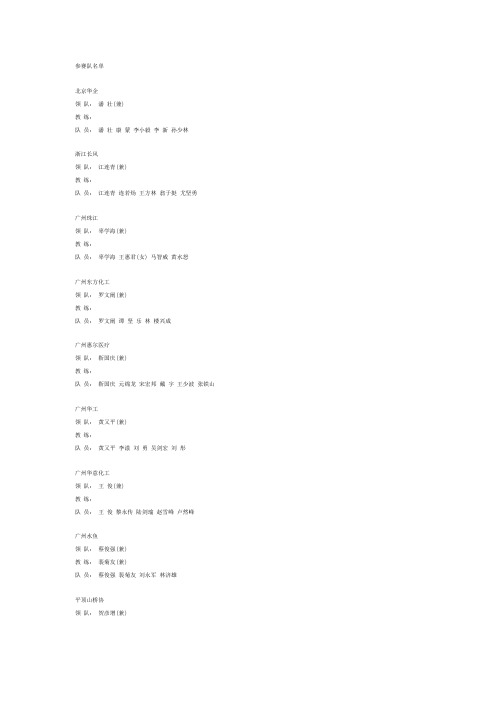
北京华企领队:潘壮(兼)教练:队员:潘壮康蒙李小毅李新孙少林浙江长风领队:江连青(兼)教练:队员:江连青连若炀王方林翁于挺尤坚勇广州珠江领队:辜学海(兼)教练:队员:辜学海王惠君(女) 马智威黄水怒广州东方化工领队:罗文阐(兼)教练:队员:罗文阐谭坚乐林楼兴成广州惠尔医疗领队:靳国庆(兼)教练:队员:靳国庆元绵龙宋宏邦戴宇王少波张铁山广州华工领队:黄又平(兼)教练:队员:黄又平李漾刘勇吴剑宏刘彤广州华意化工领队:王俊(兼)教练:队员:王俊黎永传陆剑瑜赵雪峰卢然峰广州水鱼领队:蔡俊强(兼)教练:裴菊友(兼)队员:蔡俊强裴菊友刘永军林济雄平顶山桥协领队:贺彦增(兼)队员:贺彦增王学东司卡晨张宪君平顶山体育村领队:郑永泉(兼)教练:队员:郑永泉何晓民许明圣李洁VANKE(万科)领队:王进扬(兼)教练:队员:王石张纪文王进扬刘均代光辉深圳联队领队:周磊(兼)教练:队员:周磊唐更生刘伟华何国祥马文良张强湖南安邦制药领队:易文云(兼)教练:易文云(兼)队员:易文云佘定国陈少波陈宗祥旷跃刚沈明坤湖南万通领队:彭红娜(女)教练:队员:黎日超郑克明赵强徐海兴珠海国豪领队:余国定(兼)教练:队员:余国定胡光辉胡生军邓五方罗学东珠海九州领队:陈国华(兼)教练:队员:陈国华王涛占华胡嘉深圳平安领队:林亚夫(兼)教练:队员:林亚夫沈佳祥彭健锋王锐海口火电领队:杨敏(兼)队员:杨敏程太李长湘刘跃云赖信君海南事达国旅领队:肖兵教练:队员:徐戈赵越鲍小平李建伟柴俊阳(女) 周利华(女)海南电信领队:刘幼振(兼)教练:队员:刘幼振蔡克强叶剑新陈南张翔海南人保领队:田伟平(兼)教练:陈洪深(兼)队员:田伟平李宏光陈洪深李锦生王开华海南省经贸厅领队:裴真(兼)教练:队员:裴真符布明薛宏伟肖国权娄俊杰林一叶海口景缘陶瓷领队:张文星(兼)教练:队员:刘进张文星张伟王朝川海口万国证券领队:雷军(兼)教练:队员:雷军罗帅陈昕国金复明沈士群赵志强海南中银领队:王东和(兼)教练:队员:戴永生王东和舒庆新唐轶先刘文品郑丹楠海南金海领队:王函(兼)教练:队员:王函马景荣郑会锋陈辉夏力军潘家新海南省桥协领队:王长有队员:周继太崔建武许书平蔡斌王建明贾为民三亚市领队:朱柏林(兼)教练:队员:朱柏林赵新月何博吴章杰葛朝阳刘为。
桥牌基本资料

精确叫牌法简述一、点力一般描述二、精确法开叫表三、黑木问叫(黑木问叫是发动满贯的一方问对家A、K或第一、第二轮控制的一种方法。
4NT或不寻常4为问A;问A后的5NT或5为问K。
)答叫:加一级:零或三个;加二级:一或四个;加三级:相邻的两个;加四级:相间的两个。
四、将牌问叫(开叫人直接平加叫应叫人示强应叫的花色,要求应叫人清楚地报出该花色的情况。
)回答报AKQ中的张数:加一级5+,0/AKQ(5张以上套,AKQ中无1张,下同);加二级S5,1/AKQ;加三级S5,2/AKQ;加四级S6,1/AKQ;加五级S6,2/AKQ;加六级S5+,3/AKQ。
被干扰时:×=加1级,PASS=加2级,在对方的争叫之上加1级=加3级,在对方的争叫之上加2级=加4级五、A问叫(1C开叫,任何示强应叫之后,开叫者跳叫新花色。
1D/H/S开叫之后,应叫者立即跳叫新花色。
)答叫:同级NT=所问花色无顶张大牌,其余花色无A;加一级=所问花色有1顶张大牌,其余花色无A;叫新花(问叫花色以外)=所问花色无顶张大牌,答叫花色有A;跳叫新花=所问花色有1顶张大牌,答叫花色有A;跳叫NT=所问花色无顶张大牌,其余花色有2个A;跳加叫问叫花色=所问花色有1顶张大牌,其余花色有2个A。
被干扰时:×=加1级,PASS=加2级,在对方的争叫之上加1级=加3级,在对方的争叫之上加2级=加4级六、支持问叫(在示强应叫后,开叫人叫出新花色,要求应叫人报出对开叫人花色的支持,和他手中的控制数。
)答叫:加一级JXX-,3个控制-;加二级JXX-,4个控制以上;加三级QXX+,3个控制-;加四级QXX+,4个控制以上;加五级XXXX+,4个控制以上;超过五级的任何叫品是自然叫,表明双色套牌(55或更好),4个控制以上。
被干扰时:×=加1级,PASS=加2级,在对方的争叫之上加1级=加3级,在对方的争叫之上加2级=加4级附表一桥牌比赛记分表裁判主队队长客队队长附表二桥牌双人赛随牌记分表♠副次♥局况♦年月日♣♠♥♦♣一、1♣开叫(16点以上非均型牌)(一)应叫1♦(0-7点或8点以上的假示弱)(二)应叫1♥/1♠/2♣/2♦(8点以上,5张以上套),一般至少逼叫到2NT:将牌配合时(无论开叫方或应叫方)可用将牌问叫(平加叫,一般将牌需配合),按5小/1大4小/2大3小/1大5小/2大4小/3大逐级回答,以后用控制问叫。
桥牌计分规则
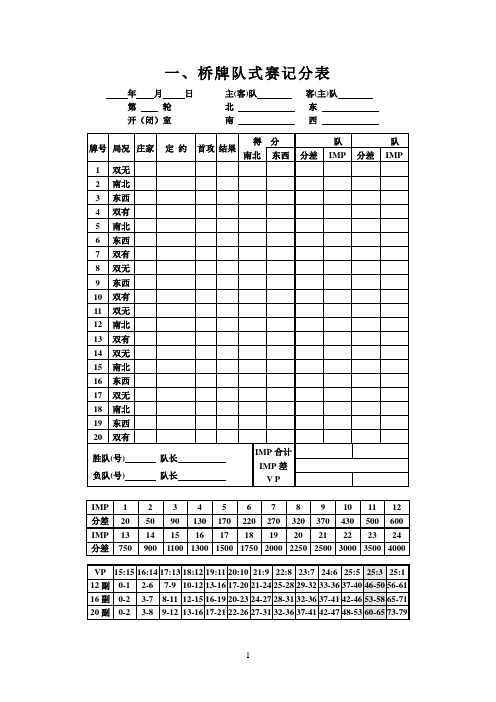
一、桥牌队式赛记分表年月日第轮开(闭)室二、桥牌单桌比赛记分北:南:东:西:三、桥牌计分规则——适用于各种桥牌竞赛(一)基本分定约方完成定约,得分如下:有将定约未加倍加倍再加倍低级花色(方片)或(梅花)每一墩20 40 80 高级花色(黑桃)或(红心)每一墩30 60 120 无将定约第一墩40 80 160 从第二墩起,每一墩30 60 120 一个定约的完成,不论成局与否,另加奖分。
(二)奖分3、定约方完成不成局定约504、定约方完成成局定约无局方300 有局方5005、定约方完成小满贯定约无局方500 有局方7506、定约方完成大满贯定约无局方1000 有局方1500四、桥牌记分(无局方)奖励分一览表:五、桥牌记分(有局方)奖励分一览表:六、惩罚分一览表:(有局方)七、惩罚分一览表:(无局方)八、桥牌记分方法(IMP国际分)九、复式桥牌1-16副牌局况表十、牌点与定约高低的关系根据对大量实际比赛的牌例进行统计分析,总结出联手牌点的数量与可完成定约的阶数大致有如下关系:25点:可完成3NT定约26点:可完成4阶有将定约(高花4S/4H可成局)28点:可完成5阶有将定约(低花5D/5C可成局)33点:可完成6阶小满贯定约37点:可完成7阶大满贯定约提示:为了得到奖励分中的成局分,不同的花色需要叫到不同阶数的定约才能成局:C、D必须叫到5阶以上,S、H叫到4阶以上,NT只需要叫到3阶。
从以上牌点与可完成定约的阶数可知:完成低花成局定约(5D/5C)要求牌点数是比较高的(28点),完成高花成局定约(4S/4H)需要26点牌点,而完成3NT无将定约只需要25点牌点即可。
因此,在叫牌的时候尽量寻求高花定约,降低对大牌点的需求。
下面对贴点记分法举例说明:第一副,双无。
北定约2S,拿8墩,正好完成定约。
得2×30+50=110分,折成3点,但南北有大牌22点,贴东西2点,净胜1点。
第二副,南北。
- 1、下载文档前请自行甄别文档内容的完整性,平台不提供额外的编辑、内容补充、找答案等附加服务。
- 2、"仅部分预览"的文档,不可在线预览部分如存在完整性等问题,可反馈申请退款(可完整预览的文档不适用该条件!)。
- 3、如文档侵犯您的权益,请联系客服反馈,我们会尽快为您处理(人工客服工作时间:9:00-18:30)。
总之,这项别出心裁别开生面的比赛,一定会在实际进行中出现不少 有趣的牌局,相对来说,三声杯比赛由于叫牌简单,信息量不大,做 庄防守要求更高,很多完全不沾边的牌也可能因为叫牌不明产生很有 意思的结果。
我们对三声杯的比赛很期待。
比赛采用积分编排赛,共进行8轮,每轮16副牌。按8 轮累计VP排列各队名次。
East 邓卓棣 Rdbl Pass
6♥
South 魏建军 Pass Pass Pass
难得能够抓到9张套,西家拿到这手牌一定很激动,在竞叫到5♥之 后,仅做了一声再加倍的东家,进取地冲上了满贯。
在三声杯的创意者陈伟望看来,桥牌的叫牌很简单,不需要那么复 杂,一个人叫三声,信息量的传递已经完全足够了,如果三声都解决 不了叫牌问题,说明这个牌手的叫牌水平不够。鉴于此想法,在海南 国际桥牌节上陈伟望赞助并创立了“三声杯”桥牌团体赛。
陈伟望是中国第一代牌手之后处于过渡阶段的那一批牌手,他在上个 世纪八十年代时开始参加桥牌比赛后来退出了牌坛。在他们那个时 代,叫牌是很简单的,约定叫很少主要靠判断,叫牌过程的信息也很 少,在攻防中对牌手的要求也高。桥牌人的特点就是离不开桥牌,过 了20多年后,陈伟望再度回到桥牌中,发现现在的桥牌比赛和他们那 个年代不同了,很多牌手都使用很多高级的约定叫,在这一点上,他 有自己的看法。
团体赛比赛,该项目的主要特点是:
参加比赛的人员没有限制,对叫牌体系没有限制,但是有特殊的叫牌 限制! 上场的运动员,在一副牌中每个运动员最多只能有三次实质型 叫牌,PASS、加倍、再加倍均不受次数的限制。 对少于三次的实质 性叫牌是允许的,对超过三次的实质性叫牌,必须取消,以后该运动 员也不得使用加倍或再加倍,只能改为PASS。
陈伟望认为,桥牌是属于西方人的东西,桥牌文化也是西方的,我 们必须尊重这个事实,同时也要尊重桥牌的传统。陈伟望非常怀念 简单自然的叫牌、认真仔细的攻防、敏锐的牌桌感觉和熟练的牌张 技巧,他认为这是桥牌的本源。其实这也是简单的一句话,就是桥 牌基本功。
在目前的国内桥牌赛场上,很多初学者不愿去加强基本功的训练,而 去到处寻找武林秘籍般的叫牌体系和新奇的约定叫,好像不使用这些 约定叫就显得跟不上潮流一般。但是很多牌手借助了约定叫的工具, 实现了某些牌上处理的正确,但逐渐地失去了自己的判断能力,慢慢 地进入了机械化打桥牌的状态,不仅个人能力提高缓慢,甚至会慢慢 退化,而且这样的桥牌失去了它本身的艺术美,因为就如工业流水线 上的产品永远比不上手工制品的价值一样。
牌例选登:无辜者的不归路!
下面是复杂而不可思议的叫牌过程:
在一场大规模的比赛中,你是北家,持牌如下:
J8 A974 873 8754
同伴开叫自然法1♣,双方有局,右手方争叫1♦,你这手普通的牌, 虽然有人同意叫1♥,但我觉得Pass肯定是大多数的选择。左手方叫 1♠,同伴Pass,右手方加叫2♠,至此为止,叫牌很正常,你也许会 稍稍动一下竞叫3♣的想法,但还是Pass。这时,意想不到的事情发生 了,左手方6♦!右手方改为6♠,你忍无可忍加倍,左手方跑6NT,同 伴加倍,三个Pass后,左手方再跑7♦,哪里逃!给我留下了
33 51 84 40 43 83 31 27 58
天府长虹 大庆星瀚
21 28 49 36 39 75 25 29 54
深圳华北工控 小珺杆
16 17 33 36 68104 14 36 50
天津海久 湖南铭凯
26 31 57 56 17 73 40 20 60
苏州太湖队 湖北银商
29 14 43 42 23 65 42 30 72
湖北银商
公开团体赛淘汰赛对阵图
三辰基金桥牌俱乐部
9 35 29 73 61 16 29 106
深圳棋院(体彩)
深圳棋院(体彩)
普得时代 PD Times 陈继 福中 李杰 侯勖 孙纲 张永革
三辰基金桥牌俱乐部 林小敏 李睿 吴尚杰 江惠波 谢召彬 苏弘彬
深圳棋院(体彩) 何立强 魏建军 李欣 朱伟东 盛明 赵雁培
中加联队 呆萌一刀
7 46 53 22 30 52 31 38 69
普得时代 PD Times 28 34 7 69 12 51 31 94 三辰基金桥牌俱乐部
深圳棋院(体彩) 60 24 1 85 16 38 21 75
中山捷高
吉林鼎元 36 10 1 47 23 28 79 130
未名队
小珺杆 20 30 19 69 TP 3570 23 16 30 69 TP 4050
2017年11月03日
陈伟望畅谈“三声杯”
三声杯这项独具特色的桥牌比赛,即将在海南国际桥牌节期间举办的 消息一经传播,很快得到了广大桥友们的兴趣,看到以上的三声杯比 赛特点可以知道,每位牌手只能在一副牌中有三次实质性叫牌,超过 三次就必须取消同时只能Pass不能继续叫牌。这条特殊的叫牌规定 迫使牌手必须在牌桌上做出简洁明了的叫牌决定,不仅接力叫、询问 叫、扣叫、爆裂叫、配合显示叫等等越少越好,而且约定叫也最好不 用,多用跳叫显示牌力和长套、加倍显示实力等等。
决赛的上半场结束后,未名队58:31IMPs暂时领先。
经过11月1日上午第三节的预赛,公开双人赛产生了最后54对晋级决 赛的牌手,下午进行了一节决赛,潘华/卢晋洲、蔡磊/鲍小平、朱敏荣 /王锐暂居前三。另外在IMP双人赛中,陈新义/刘世铜、李晓东/曹荣 欣、刘占学/李晓昕名列前三位。
" 三声杯 " 比赛方法
开室 West
North 你
1♦ 2♠ 6♠ Pass Pass Pass
Pass Pass Dbl Pass Dbl
你需要在这么复杂的局面下首攻。
East
1♠ 6♦ 6NT 7♦ Pass
全手牌揭晓在下期公报
South
1♣ Pass Pass Dbl Pass Pass
05
海南南山2017中国海南(三亚)国际桥牌节
三声杯的特殊规则,造成了打三声杯牌手的特殊应对方法。首先体系 必须做更改,比如精确法不适用,因为1♣强开叫就占用了一个叫品, 开叫上要尽量简单同时尽量显示较多的信息,其实饭桶体系就挺适 合,1阶开叫自然、2阶开叫也自然,没有强开叫。另外,开叫1NT的 点力范围可以适当扩大等等。同时,要合理利用三声杯的规则,比如 同伴已经叫完三声,此时的加倍必然是惩罚性加倍。
基于这种想法,陈伟望希望通过三声杯这个比赛,唤起桥牌回归本 源、牌手应该更多追求基本功而不是追求技术手段这个方向。
“三声不是一个体系,也不是一个规则,而是一种桥牌理念”。这就 是陈伟望创办三海南(三亚)国际桥牌节
2017年11月03日
本土牌手的身影
在桥牌节的比赛中,本土牌手主要参与到保障与服务工作,但也时有 参与到比赛中。由于海南桥牌起步较晚,与国内平均水平尚有较大差 距,许多热心桥牌的桥友为海南桥牌运动的发展献计献策,甚至身体 力行,积极参与到海南的桥牌活动中,为培养本土牌手做出了积极的 贡献,海南的桥牌爱好者是不会忘记的。
参加比赛的相关规定
所有进入赛场参加比赛的人员将必须佩带证件,没有佩带证件的人员不得参加比赛。
手机禁止带入赛场,一经发现按规定处罚。
约 定
上场运动员每人带一份约定卡,本次比赛采用全场提醒,以实行全场警告,对没有带约定卡,第
卡 2轮及以后将直接扣0.5VP。
比赛期间运动员要离开牌桌,必须向裁判报告,经同意后方可离开。去洗手间要同桌结伴同行。
海南师范大学 ABC
23 23 46 28 7 35 32 54 86
五指山圣河湾 中山捷高
13 35 48 29 42 71 44 42 86
浙江钱塘(动享网) 46 45 91 34 38 72
贵州电力桥友
27 5 32
北京信远队 吉林鼎元
21 29 50 38 39 77 37 34 71
未名队 Djarum Plus
中山捷高 张智军 何伟炜 黄勇 任伟军 陈华 陈莹
未名队
21 55 28 104 25 12 28 65
湖北银商
未名队
吉林鼎元
毕书广 何文炯 魏宇 董春晖 静旭 施斌
未名队
邓卓棣 刘京 胡林林 刘英皓 胡俊杰 陈一超
小珺杆
黄丁杰 唐毅 尚德勇
刘视湘
湖北银商
张杰 曾翔 俞国兴 戴克 石江郧 王军
海南南山2017中国海南(三亚)国际桥牌节
世纪东方 广西天虎软件
15 41 56 23 5 28 53 30 83
Indonesia Mixed
8 18 26 69 54123
三辰基金桥牌俱乐部 42 42 84
于易 深圳棋院(体彩)
51 24 75 107 107 16 62 78
深圳南港动力 宜昌广博风行队
27 24 51 7 7 16 23 39
2017 年 11 月 07 日 第 07 期 3rd Nov 2017 Bul_07
公报主编:标兵 平面设计:邢铁军
今日比赛
公开团体决赛 09:00--10:50 公开团体决赛第三节 11:00--12:50 公开团体决赛第四节
三声杯团体赛 14:00--15:50 三声杯团体赛第一轮 16:00--17:50 三声杯团体赛第二轮 18:00--19:50 三声杯团体赛第三轮
采用录入会员号码自助打印本队记分表。
场馆内全部实行禁烟,有违反者,按相关规定处罚。
*所有参加颁奖的运动员需着整齐服装,穿短裤拖鞋者不得参加领奖!
02
普得时代 PD Times 37 35 72 23 52 75
海南钙立速队
21 34 55
Indonesia Open 湖北地矿
55 14 69 27 12 39 9 48 57
2017年11月03日
【赛事焦点】
公开团体赛决赛上半场 —— 深圳棋院 vs 未名队
